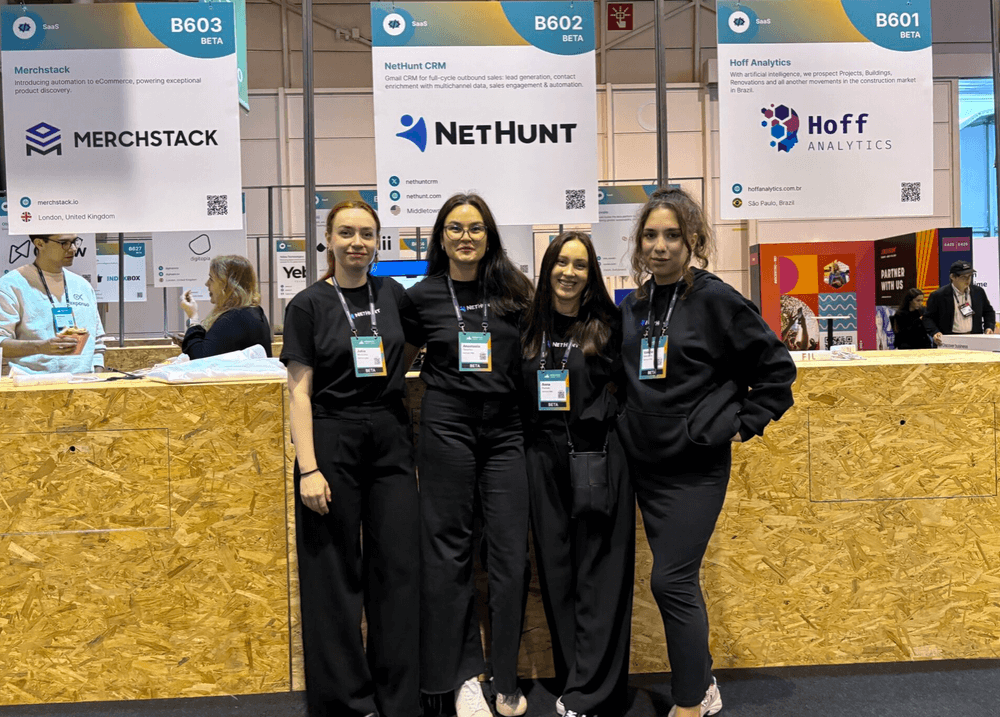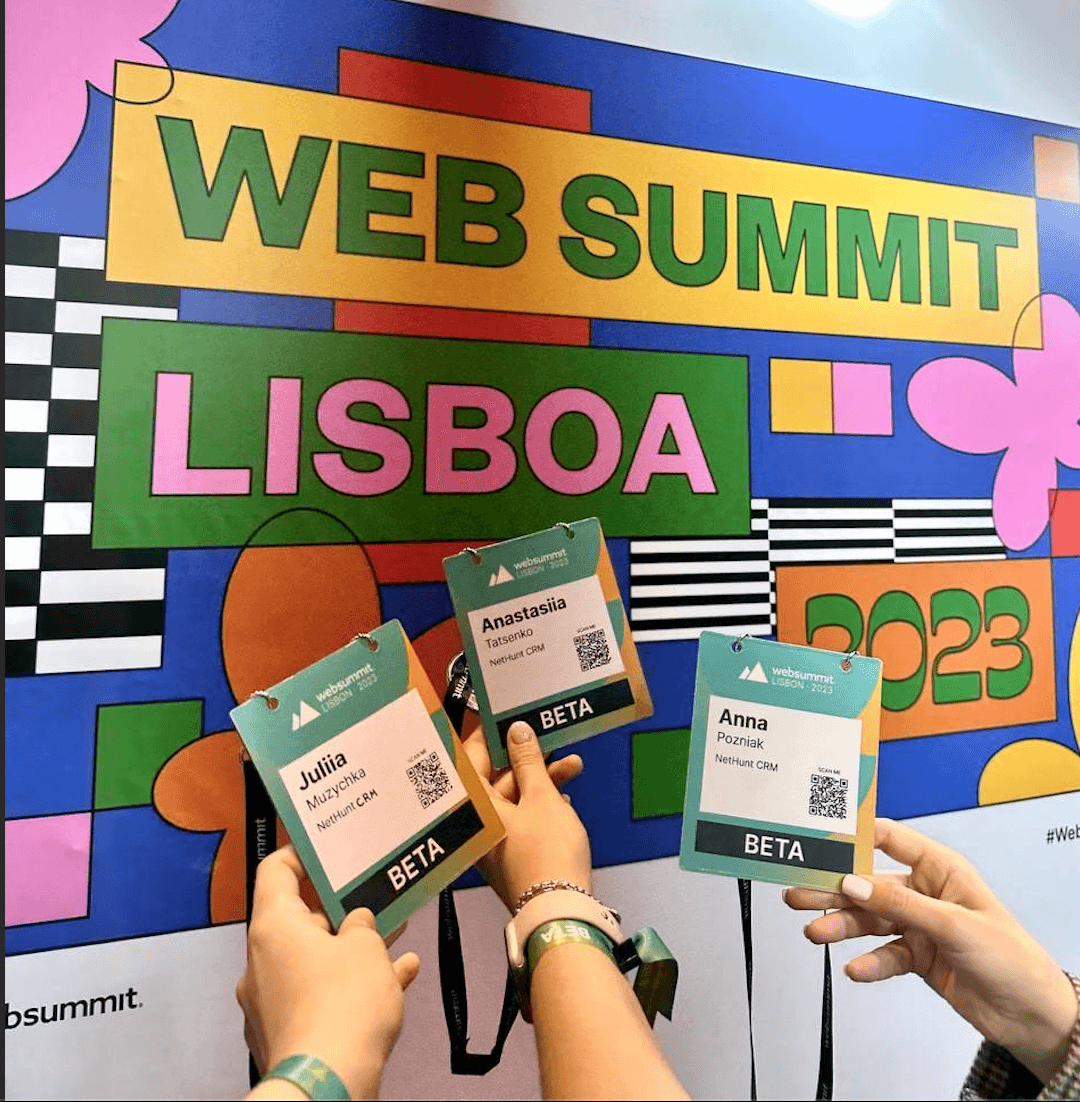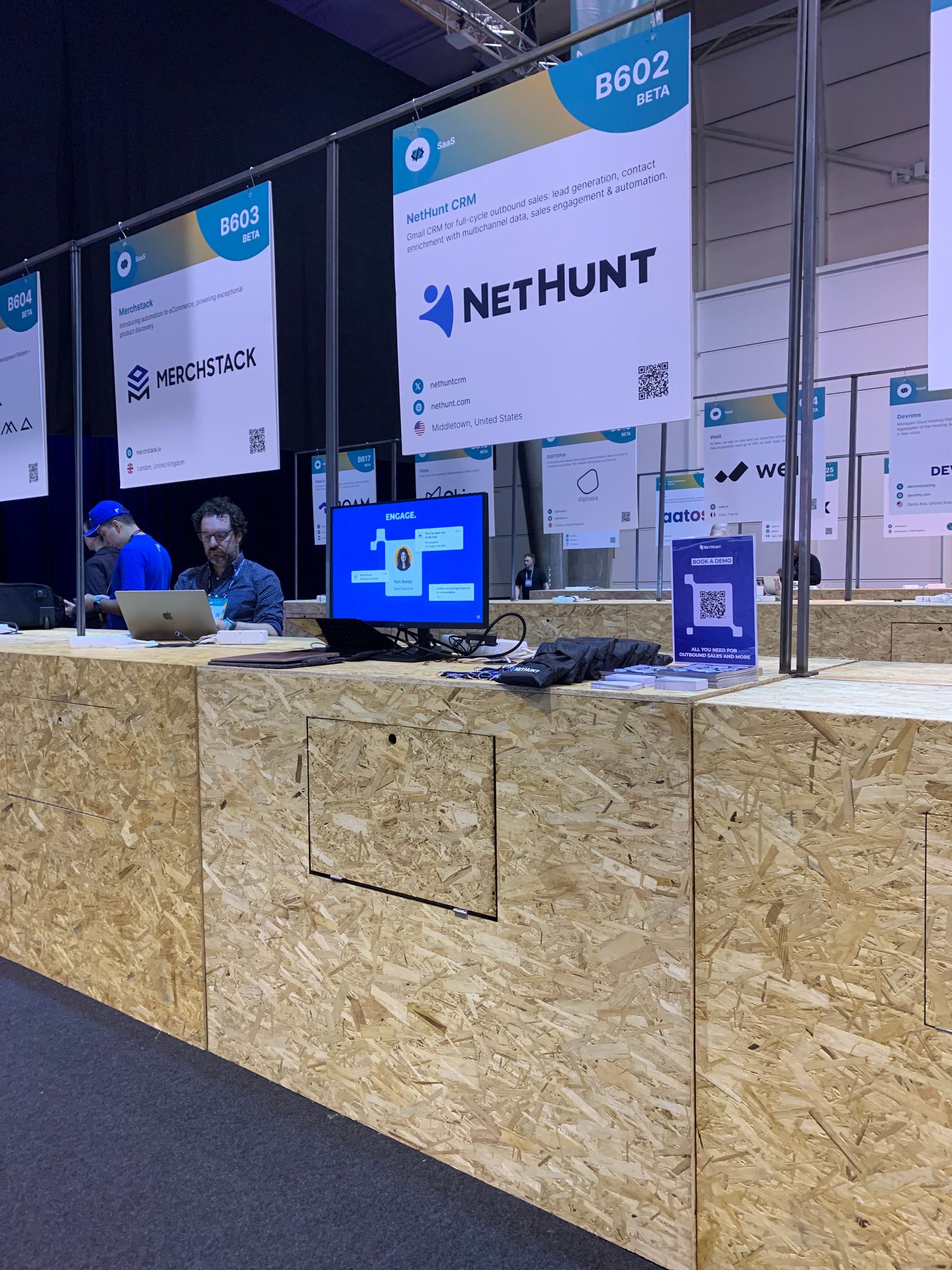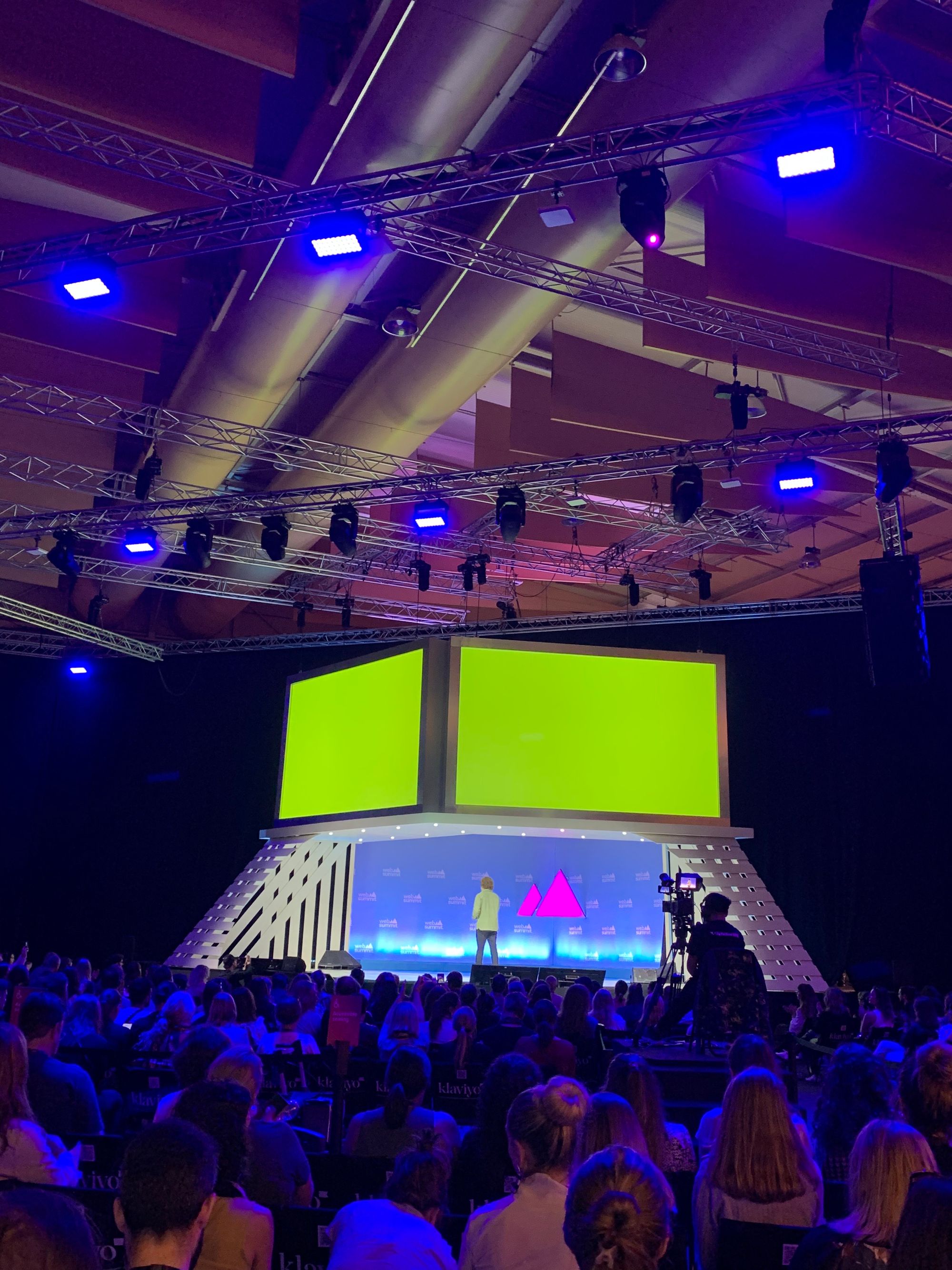How to achieve the goals you set for yourself at conferences — and more
This year’s Web Summit left us blown away. Seriously, it was great! We’ve had a lot of lovely conversations with people. It was wonderful to exchange experiences and professional advice.
We’ve also got the chance to present our latest update at the BETA startup zone. So, we’ve collected some great insight into what it’s like to run a showcase table and achieve the goals you set for yourself at conferences.
We’ve condensed all the knowledge we’ve gotten from our time at the conference for you to also take advantage of!
Without further ado, here are our insights…
Our insights from Web Summit 2023
These tips will help you attract more conversation and conversions to your offering. The next time you see the NetHunt CRM team at a conference, you’ll see us taking advantage of these insights ourselves!
Decide your goals for visiting the conference in advance
Web Summit is an absolutely massive conference with more than 75K attendees.
You might want to find investments for your project, generate new leads, gather feedback, validate some hypotheses, or get media coverage. But there’s no possible way to have the time to do everything.
Be sure of your goals when going to the conference. Clarify them with your team and choose three priorities max.
Once you’ve established your goals, tailor your strategy accordingly and prepare yourself for the specifics of what you’d like to accomplish. For example:
- If you’re seeking investment: Prepare detailed financial info for the people you’ll be meeting. Structure your pitch accordingly.
- If you’re looking for leads: Focus on socialising and building new connections. Hang out in places where your buyer persona would likely hang out in.
Start booking meetings before the event
Even if a prospect you’ve wanted to chat with for a while is going to the conference, chances are — you won’t bump into them, or they won’t have the time to talk to you. How come? Because all the cool kids book their meetings before the conference starts!
Make do with what the conference gives you. When we were booking our meetings, we downloaded the official Web Summit app and filtered the people by criteria that fall under our ICP. We crafted different pitches for each of them to increase the chances of getting a positive reply.
When picking leads, choose 1–3 audience segments and focus on those ones. We targeted two. First, start-ups to offer them our Startup Program. Second, established companies who'll benefit from switching to our solution.

Pro tip: Connect with existing clients to boost retention. Since we’re a digital company, we rarely see our customers face-to-face. That’s why we sent out an email campaign to our clients and prospects before the conference. We told them about the opportunity to meet us in real life. As a result, quite a few of our clients came by to meet the team in person.
Use every opportunity to talk to the media
It’s not just businesses at conferences; it's media too! However, the areas where the media hangs out may be restricted to media attendees only. If you’d like to dedicate time to talking to the press — you’ll need to find a way in.
The easiest way to get into the media village is by booking an interview with a journalist to be conducted in that area. Once you do that — you get a day pass, which allows you to hand around the area some more and get to networking!
However, getting in is the easiest part, as you’ll still need some finesse to get the desired results. Striking up conversations is the first and most important thing to do. However, walking up to someone and saying, “Hey, interview me!” isn’t how to move forward. Instead, keep your eyes peeled for badges that are distinct from your own. Why? Well, journalists' badges often have different colours to them more identifiable.

Once you identify a journalist, you’re going to have to try and read the name on their badge from afar in order to then run it through the conference app and/or Google to be more prepared to strike up a conversation. So, if you’ve been naturally blessed with good eyesight — you’re at an advantage. If you require glasses or lenses to see clearly at a distance — make a mental (or better yet physical) note to ensure you don’t forget them.
You should list the media you want to speak to at the conference. If you haven’t made one yet, you should. Speak to journalists working at the publication you’re interested in, even if they don’t write about your topics. If you pitch your ideas well, they’ll eventually get to people who can bring them to life.
Oh, and if you’re looking to book meetings with journalists beforehand, here’s how we did that:
- Due to us presenting NetHunt CRM at the Beta Startups area, we had a list of media attending the conference and the topics they covered.
- Out of that list, we’ve reached out to the media that, in our opinion, would be interested in speaking to us.
However, if you didn’t get a list of journalists like we have, here’s an idea for you to follow:
- Look up last year's conference hashtag on social media websites such as LinkedIn and Twitter to understand who attended the conference.
- Identify the journalists you’d like to speak to if the chance arises.
- Reach out to these journalists and ask them whether they will attend this year's edition. If they are, go ahead and book a meeting.
If you’ve signed up for events like speed networking, you can also establish connections with journalists there. We have built a few great connections with journalists we met during this activity.
Use every opportunity to network
Large conferences come with large queues. Sure, a queue seems awful to have to go through. But on the other hand, you’re there spending quality time with fellow attendees — people there to do the same thing as you! Use this opportunity wisely and chat with some people in the line whilst waiting for your turn.
The parties are also an excellent place to network if that’s the case, and these usually happen after all the other activities have finished. It’s a great opportunity to network in a more relaxed atmosphere. For example, we have booked our first call with a prospect during a pre-party. This means we already had one lead before we even got through the event's doors. Pretty neat, huh?
Enhance your booths and stands
A lot of people go to conferences. Naturally, plenty of companies set up their stands to show off all the cool stuff they’ve been working on since last year. Attracting interest in this kind of environment means standing out from the crowd.
The company's booth is like a business card.
It should attract the audience and leave a positive impression. However, at Web Summit, we noticed that many descriptions contained general phrases like: "Cutting-edge", "Innovative", "Revolutionary product", and “Increasing efficiency and productivity”.
If you really want to stand out from the crowd, avoid clichés. Focus on specific achievements, unique advantages of the product or service, and business values.
For example, on our showcase table, we wrote: "Gmail CRM for full-cycle outbound sales: lead generation, contact enrichment with multichannel data, sales engagement and automation.”

Visitors of the event approached us and asked about the specific functionality that we mentioned in our description.
Think of using a spare monitor to showcase your product through a video. This simple trick can spark curiosity and invite questions. Some of the visitors asked us to show exactly what they saw on the video behind us.
Interaction points are crucial. Set up spots for demos or casual chats, making your booth inviting for everyone, from investors to media. For instance, a demo corner for quick product walkthroughs can keep visitors engaged.
Remember, placement matters. If you're a startup, being in the startup zone means your target audience finds you quickly. And have short, punchy pitches ready. Think of these as your product's elevator pitch — quick, engaging, and to the point. This approach keeps conversations flowing and makes every interaction count.
Make it easy for people to take the next step
Conferences are busy events. As you probably will be, everyone is rushing to get the most out of their time. Therefore, it’s vital to make it easy for your prospects to take the next steps after your chat. Whether it be connecting on LinkedIn, or booking a call once everyone’s home and recovered, making it easy for people to do so is not any less important than getting them interested in the first place.
We tackled this solution by creating QR codes for our LinkedIn profiles and setting that code as our phone home screen wallpaper. By doing this, we could share our profiles lightning for anyone interested in sending us a connection request. We’ve also printed a QR code for our booth, allowing our prospects to book a demo quickly and easily.
When you’re not near your booth or stand, it’s good to have QR codes for booking a demo along with your contact information set as your home screen. Just in case you bump into an interesting conversation on your way from the food court.
As any salesperson would tell you, however, your prospect having your contact info is not a reliable way to secure a follow-up, and definitely not as reliable as having your prospect's contact info. Write down the information of everyone you meet at the conference, and remember the conversations you had, the problems they’re facing, and any concerns they have about your offering.
“How do I remember what we talked about even half an hour later? I’ve had hundreds of conversations daily at the conference!” – you may wonder. We photographed the prospect's badge to remember their name, position, and company. Afterward, we’d write their contact information and record a short voice memo summarising the conversation.
Naturally, we also dedicated a few minutes every day to input all of this information into the CRM, as well as automatically transferring the information from our prospect's LinkedIn profile to a CRM record.
Pitch but stay human
In the bustling atmosphere of a conference, your pitch needs to resonate on a human level. Start by engaging in their world. Learn about their business first. This could be as simple as asking, "What's the biggest challenge you've faced this year?" Then, tailor your pitch to address their specific needs. It shows you're not just selling a product but offering a solution.
An essential part of pitching the right way is ensuring your whole team is on the same page. Prepare an elevator pitch, a single sentence your team can use to describe your product and the pains it solves. It’s vital for your team to be in sync to make sure that the experience prospects get with your offering is always the same.
A cool thing happened at the Web Summit. My colleague and I approached the person and started actively talking about NetHunt СRM. He listened to us and then said: "I think I have already heard the same words about this product from someone yesterday". And that's when we realised that our team works like a coordinated mechanism. Our Chief Customer Officer, Anastasia Tatsenko, shared the info with him the day before.
Anna Pozniak, CMO at NetHunt CRM
Go beyond business. Compliment their achievements or ask about their journey. This creates a deeper connection. For instance, asking, "How did you get started in your field?" can open up a more personal conversation.
Last, gather insights. Ask how they use similar products and what they wish were different. After the conference, these insights can be a treasure trove for your development team. It's a cycle of listening, improving, and offering something even better next time.
Learn about relevant media topics
Heading into any conference, it's wise to have your finger on the pulse of media interests. The spotlight at the Web Summit was on AI, Finance, Venture Capital, and Sustainability. Even if these aren't your playground, weaving them into your narrative can be a game-changer.

Here's the trick. It's not about a total pivot but intelligent alignment. Let's say you're a tech whiz. Spin your pitch to show how your tech taps into sustainable solutions or could be the next big thing for investors. This isn't just about blending in. It's about using these trending topics to sculpt your future marketing strategies.
Think of it as a chess move. Find that intersection where your business meets sustainability. This approach doesn't just spice up your conference chats. It sets the stage for your marketing to shine, opening doors to innovation and fresh market territory.
Use merchandise
At conferences, big companies often roll out an impressive array of merchandise. But don't let this dampen your spirit. Your merchandise can still make a splash with a bit of creativity.
The key? Gamify the experience. Make getting your merchandise fun and engaging. Picture this: attendees line up to spin a wheel at your booth, each spin offering a chance to win your branded goodies. It's not just about giving away pens or notepads. It's about creating memorable moments that attendees associate with your brand.
This approach does more than just distribute merchandise. It draws people to your booth, sparks conversations, and leaves a lasting impression. It's a playful way to engage potential clients and make your brand stand out, regardless of your size.
Bottom line
That’s all we have for you for now. With these insights, the next conference you decide to attend will be a resounding success. You’ll build new connections, find potential clients, and just have a great time in general! Also, remember that each business is different, as is every conference. Adapt our insights to fit your offering and the conference you will visit.

Table of Contents
Crack the sales formula with CRM Lab
Twice a month, receive actionable CRM content to your inbox.


